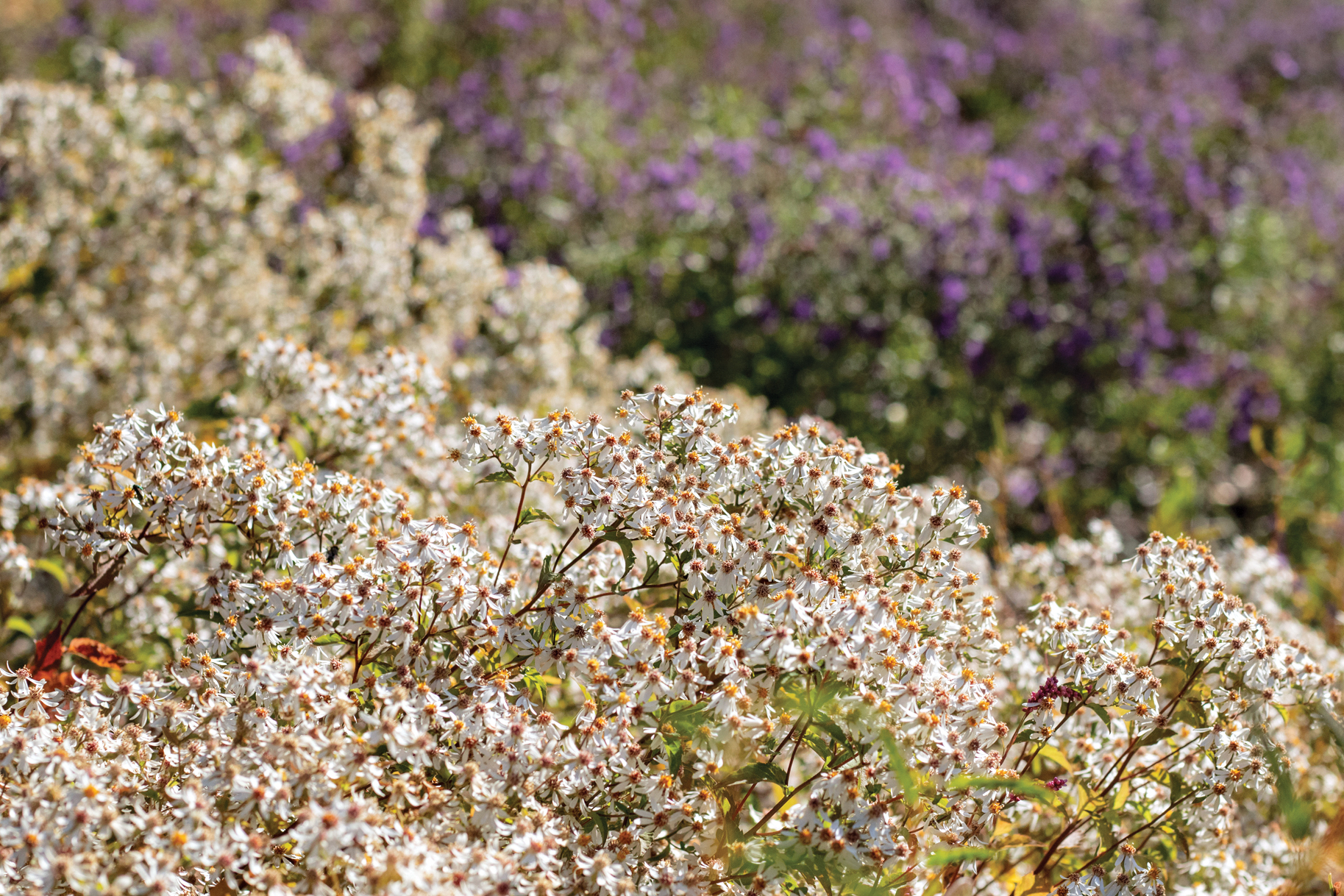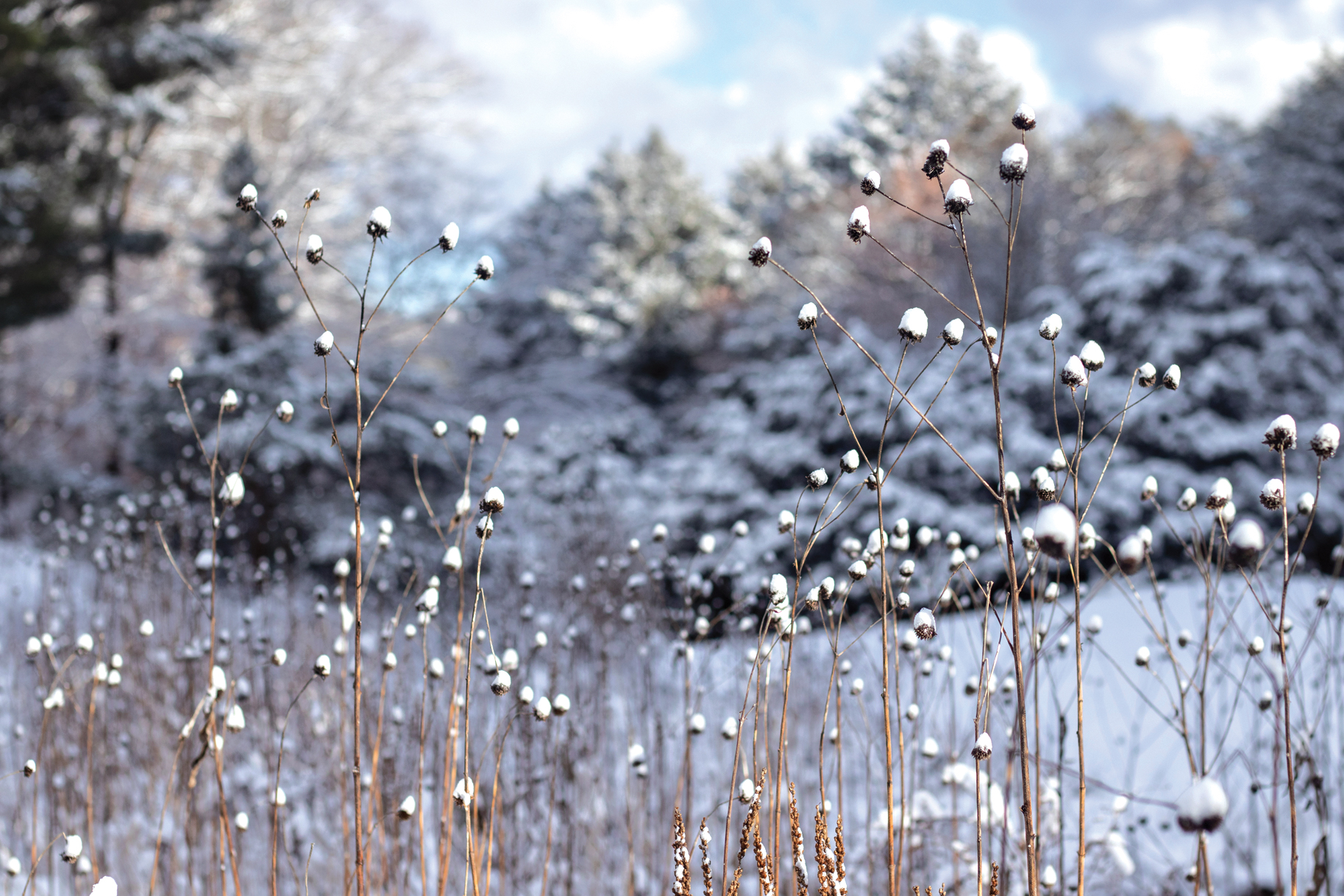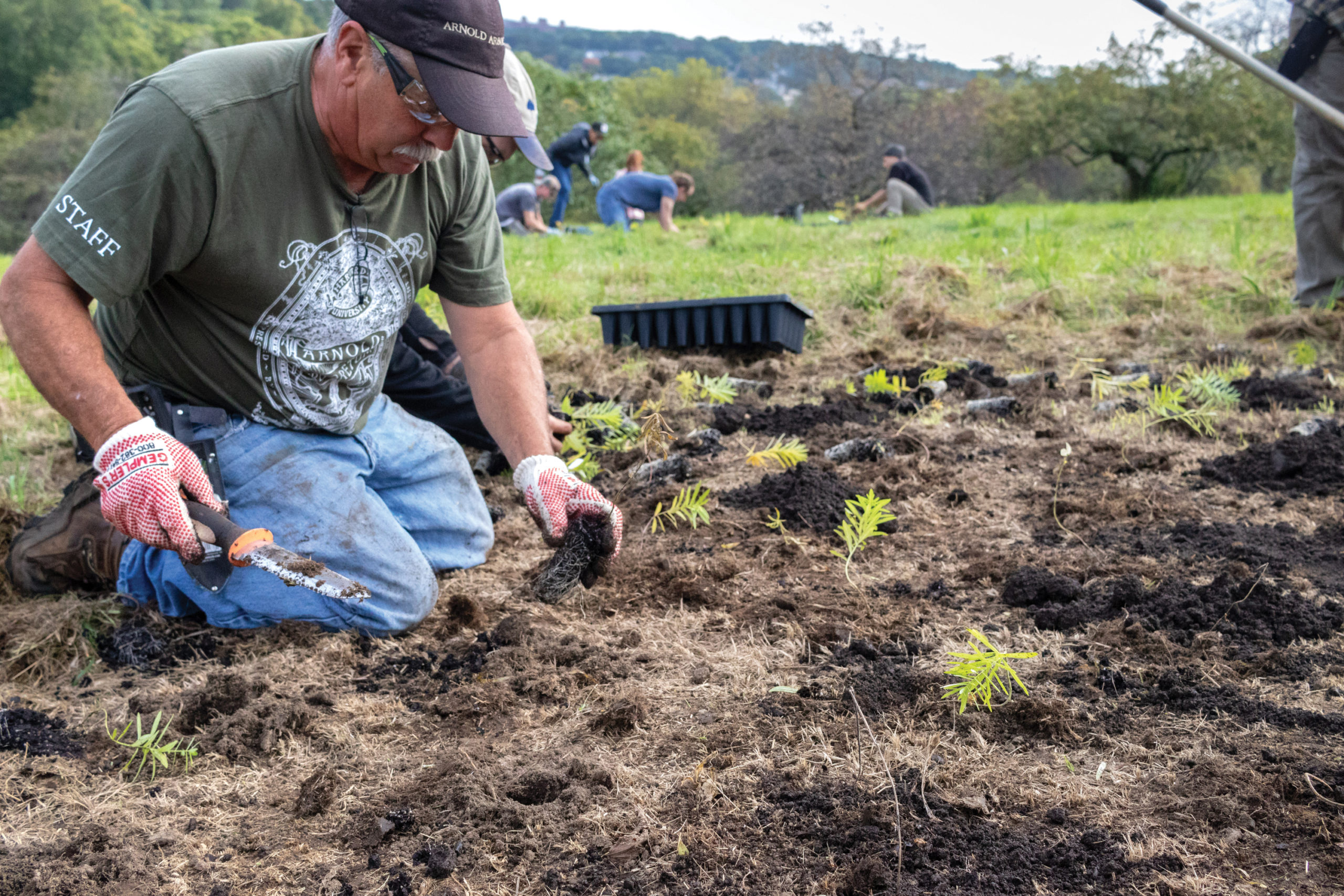While walking down Oak Path last October, I was drawn to a glint of yellow among the dappled shades of green. I carefully stepped through the tall grasses and clumps of wood aster (Eurybia divaricata), and found, to my surprise, a blue-stemmed goldenrod (Solidago caesia) in bloom. A few bumblebees busily gathered pollen in the afternoon light, hanging on the plant’s characteristically staggered flowers that ascend like golden rungs on a ladder.
Although blue-stemmed goldenrod is a common native plant, I had never seen one growing in the middle of the oak collection. Despite providing ideal habitat, with the high canopy allowing ample sun, the collection is typically mowed, which kills young perennials long before their autumn blooms. In 2019, however, much of the oak collection was purposefully left fallow to encourage the growth of herbaceous species. The lack of mowing resulted in an abundance of common violets (Viola sororia) in the spring followed by blue and white asters (Symphyotrichum and Eurybia), several species of goldenrod (Solidago), and, presumably, some very pleased bumblebees in the fall.
Unlike the accessioned trees (each lovingly labeled, monitored, and cared for), the wild populations of herbaceous plants, such as the blue-stemmed goldenrod, often exist in anonymity. A new appreciation for the herbaceous understory’s benefits to the woody collection and to the urban ecosystem, however, is redefining the Arboretum’s approach to these plants. The horticulture team has, among other things, begun leaving areas fallow to encourage spontaneous populations. Staff have also begun collecting and propagating herbaceous plants for landscape renovations, and these plants have been introduced as ground cover in the formal collections. An herbaceous shift is underway.
A Naturalistic Legacy
Although the Arnold Arboretum is famous for its history of plant exploration and its collection of temperate woody species gathered from around the world, it is perhaps less well known that the landscape itself was originally intended as an homage to New England. Both Frederick Law Olmsted, the landscape architect who designed the Arboretum, and Charles Sprague Sargent, the Arboretum’s founding director, guided this aesthetic, drawing on shared horticultural principles and a desire to mimic the region’s natural ecosystems. Although the resulting naturalistic aesthetic is taken for granted these days, it is easy to overlook how innovative and even radical the Arboretum’s landscape was considered at the time.
By the late 1800s, city planners across the United States were beginning to think about the importance of green space for the public. The industrial revolution had brought the masses into the urban core, where there was little escape from toil in factories. Wealthy homeowners, on the other hand, developed their gardens in the fashion of the day, filling greenhouses with imported tropical plants and their yards with various exotic specimens. In many cities, newly built public parks reflected the taste of the wealthy, with formal gardens and annual beds taking pride of place.

Olmsted’s vision for the Arboretum, and for the larger parkway of which the Arboretum is one part, could not have been more different. He planned for the winding roads to be bordered by layers of natural-looking shrubs and trees in order to invoke feelings of rural country lanes. Olmsted preferred woods and natural areas, interspersed with sweeping lawns that were designed to be maintained by cows and sheep. This preference, however, didn’t preclude the use of non-native plants. Olmsted outlined this idea in an 1888 letter to the editor, in Garden and Forest, a publication established and overseen by Sargent: “May we not (as artists) think that there are places with us in which a landscape composition might be given a touch of grace, delicacy and fineness by the blending into a body of low, native tree foliage that of the Tamarisk or the Oleaster … ?”
Fortunately, Olmsted had a more than willing partner in Sargent. Known for his passion for woody plant collection and discovery, Sargent formed the cast in which the Arboretum was molded. Many of the horticultural decisions he employed at the Arboretum could also be seen at his Brookline estate, Holm Lea. Although Sargent rarely opened Holm Lea to visitors, those granted access marveled at his naturalistic integration of native and non-native trees, shrubs, and herbaceous plants. Wilhem Miller, a writer for Country Life, praised the estate, in 1903, as an example of “‘natural’ landscape-gardening.” Miller observed that “while there are few places that are more cosmopolitan—so far as kinds of plants are concerned—the visitor will search in vain for anything that sounds a discordant note.” Similarly, Nathaniel Greene, a journalist writing for the New England Magazine, in 1908, observed that “Professor Sargent wants nothing on his place that is not harmonious with a New England landscape.”
The combination of Olmsted’s landscape philosophy and Sargent’s horticultural decisions resulted in an Arboretum that combines plants in a naturalistic way. Greene noted that this combination, as demonstrated at Holm Lea, differed from the approach used in parks in other cities, which “tend to look alike, because they use chiefly tender bedding-plants, which are costly, ephemeral, loud, garish.” A fitting, albeit melancholic, example of Sargent’s lasting sympathies towards naturalistic plantings was the location of his memorial service held on June 9, 1927. Rather than celebrating his legacy near the Hunnewell Building where he spent much time, or under one of the species named in his honor, the event was held in one of his favorite locations along Bussey Brook “where white oaks, a white pine, and a white beech, all native to American soil, overhung the temporary platform.”
The Spontaneous Flora
While Olmsted designed the Arboretum’s bucolic setting and Sargent filled it with plants from around the world, the responsibility of documenting the landscape’s herbaceous species fell to staff working on the grounds. In the early years, this role was filled by Ernest Jesse Palmer, a self-taught botanist from southwestern Missouri. Palmer came to the attention of Sargent around 1901 after he mailed Sargent fruits from several species of hawthorn (Crataegus), a group of plants that Sargent was beginning to research intensely. The pair corresponded for decades, with Palmer regularly collecting plant material for the Arboretum, before he finally accepted a position as a botanist collector and moved to Boston in 1921.
Palmer soon began to inventory and study the spontaneous herbaceous flora at the Arboretum. Fortunately, he assiduously documented his observations, with the vast majority of the 2,235 spontaneous plant vouchers in the Arboretum’s herbarium attributed to his name. He compiled his findings in an article titled “The Spontaneous Flora of the Arnold Arboretum,” first published in a 1930 issue of the Journal of the Arnold Arboretum. Palmer’s “Spontaneous Flora” remains a valuable benchmark for studying the diversity of wild plants in the Arboretum landscape, and the wider region.
Unsurprisingly, the current wild plant composition is much different than Palmer’s records describe. In his day, there was greater overall herbaceous plant diversity. Palmer noted “bits of open meadow” between the young trees in many of the collections, “where the grass and other undergrowth is cut at infrequent intervals.” Many plants flourished among what were then saplings in the hawthorn collection, including nine species of aster and goldenrod. Included among them were the “pretty violet rays and yellows discs” of the flax-leaved aster (now classified as Ionactis linariifolia), which were “especially abundant and showy.” These days, flax-leaved aster is a rare sight among the hawthorns.
Other parts of the Arboretum, however, seem unchanged. Palmer observed, in the 1920s, that “Elderberry … Joe Pye Weed … Poison Hemlock … New England Aster … and New York Aster are most conspicuous” along the steep banks of Bussey Brook, a spot where they continue to thrive. Somewhat amusingly, he also noted that the “curious little parasitic Love-vine or Dodder twines its amber evanescent stems about some of [these] upright herbs.” Despite periodic assault by a century’s worth of horticulturists intent on its removal, a healthy population of dodder (Cuscuta gronovii) persists in that exact location to this day.
Palmer’s wild plant baseline also proved invaluable for follow-up surveys documenting the change of spontaneous species through time. At least nine species from his 1930 publication no longer grow in the Arboretum, and four of those are now endangered in Massachusetts. Of the six species of orchid that once grew in the landscape, only pink lady slipper (Cypripedium acaule) has been recently documented. Ten additional herbaceous species are on the state watch list, and their status in the Arboretum is undetermined. Ironically, Palmer, who worked without the benefit of historical documentation to guide his observations, lamented that many plants which “might have been found … [are] now gone forever from the Arboretum” as a result of physical alterations ongoing in his day.
Cultural preferences likely played a role in changing species abundance. Lawns were increasingly viewed as more favorable than unkempt meadows, and they allowed greater mobility throughout the collection. Although horse-drawn sickle mowers were the tool of choice by the early 1900s (and were used by Sargent’s land managers at Holm Lea), frequent mowing would not occur until the Arboretum acquired gas-powered machinery in the midst of labor shortages during World War II: a tractor, with an attachment for hay cutting, in 1945, and two lawn mowers in 1946.


Mowing also provided a cost-effective and reliable tool for keeping down unwanted vegetation, which became especially important as invasive plant populations increased. The asters and goldenrods that Palmer described on Peter’s Hill were soon jostled by Oriental bittersweet (Celastrus orbiculatus) and black swallowwort (Cynanchum louiseae), just two of many invasive species that harm the valuable woody specimens they grow among and on. While frequent mowing can mitigate these problems, it also kills the native grasses and forbs that once beautified the collections, depressing overall biodiversity. Mowing has also resulted in mechanical damage to accessioned plants and contributed to soil compaction collection-wide.
Although no comprehensive bulletin of spontaneous plants has been published since Palmer’s last edition of “Spontaneous Flora,” in 1945, staff and researchers continue to assess the status of herbaceous plants and other spontaneous species. Peter Green updated Palmer’s list, in 1962, when he published “Herbaceous Aliens in the Arnold Arboretum” in Arnoldia. Leslie Mehrhoff, the herbarium curator at the University of Connecticut, reviewed and updated Palmer’s baseline while documenting changes in invasive plant populations beginning in 2008. Mehrhoff intended to publish a comprehensive update to Palmer’s list, but the project ceased after his death in 2011. Around that time, Walter Kittredge, of the Harvard University Herbaria, completed a multi-year taxonomic project, verifying the identifications for the well-over two thousand herbarium specimens that constitute the Arboretum’s spontaneous flora collection. These individuals have kept institutional knowledge alive by channeling Palmer’s surveying efforts, allowing the Arboretum to keep track of changes to herbaceous species composition through the years.
Shaping the Herbaceous Layer
In 2017, new strategies for increasing the ecological value of the landscape began reshaping the herbaceous flora once again. These changes started when Andrew Gapinski, the Arboretum’s head of horticulture, organized the first official Herbaceous Committee. The group, of which I was a founding member, was initially concerned with identifying areas in the landscape where mowing pressures could be reduced or eliminated, in an effort to limit mechanical and compaction-related damage to accessioned plants. Compacted soils had compounded after decades of running heavy, gas-powered equipment directly around and beneath the plants. A healthy herbaceous layer would allow for staff to leave “no-mow” zones, mitigating future compaction and reducing fossil fuel inputs. The committee also anticipated that, as shorter-lived herbaceous species come and go, their decomposing roots would help to break up and enrich the compacted soil.
The committee discussed ways to increase the herbaceous diversity and how these collections could subsequently be managed by horticultural and curatorial staff. Irina Kadis, former Arboretum curatorial assistant and native plant expert, was central to this effort. Her knowledge and cross-checking of Palmer’s observations informed the committee’s reintroductions. The committee also relied on her personal knowledge of natural lands to determine from where to source the plants.


In order to maximize the ecological benefits, as well as to mimic the naturalistic setting which Palmer described, the committee agreed to only introduce plants native to Massachusetts. These plants would, ideally, be sourced or collected from wild populations, allowing the Arboretum to document provenance and conserve local ecotypes. This means that, for a widespread species like red columbine (Aquilegia candensis), which has a native distribution stretching from the East Coast to the eastern Great Plains, the Arboretum would only acquire locally sourced wild material, to protect our regional genetic diversity.
Acquiring wild seed poses a significant hurdle and is an ambitious jump for an institution focused on woody plants. However, there is ample precedent for building the collections with plants from New England. In the 1870s, the Arboretum propagator, Jackson Dawson, used a horse and buggy to collect native shrubs and trees to fill the young Arboretum’s nurseries. Dawson continued to make local collections throughout his more than forty-year career, but recent local efforts are the first to strategically add to the Arboretum’s herbaceous understory. I helped organize collaborations with the Native Plant Trust, the Trustees of Reservations, and the Massachusetts Audubon Society, allowing staff to purchase or collect seed from beautiful natural areas close to home.
These revised management strategies have resulted in prominent no-mow zones on Peters Hill and in the conifer, oak, birch, linden, and maple collections. The meadows on the face of Peters Hill are particularly notable. Although cool-season grasses comprise the majority of the spontaneous vegetation, large stands of common milkweed (Asclepias syriaca) and goldenrod are emerging. In addition, over two thousand butterfly milkweed (A. tuberosa) plants dot the hillside, propagated in the Dana Greenhouse from seeds collected on Martha’s Vineyard and donated by the Polly Hill Arboretum. The meadow also provides habitat for a variety of insects, birds, and mammals. A pair of eastern bluebirds, spotted in the spring of 2019, were the first to successfully nest in the Arboretum’s collection since 2006.

In the Kent Field meadow, down the road from Sargent’s chosen memorial site, masses of introduced mountain mint (Pycnanthemum muticum), common boneset (Eupatorium perfoliatum), butterfly milkweed (Asclepias tuberosa), little bluestem (Schizachyrium scoparium), great blue lobelia (Lobelia siphilitica) and golden Alexanders (Zizia aurea) provide food and shelter for wildlife throughout the seasons. In late summer, monarch butterfly caterpillars carefully munch on the milkweed, while a variety of butterflies and bumblebees cover the stands of mountain mint and purple-stemmed aster (Symphyotrichum puniceum). In the evening, Kent Field is a prime spot to observe bats darting for insects, while great horned owls use the towering conifers to watch for unwary voles and mice.
In addition to revitalizing meadows, the Arboretum is also actively collecting and purchasing herbaceous plants in response to other forms of landscape change. In 2018, a considerable number of beeches (Fagus) were removed from the Arboretum’s collection, due to an outbreak of beech bark disease. This caused a massive shift in the growing conditions for the herbaceous layer, which went from deep shade to full sun essentially overnight. Expansive areas were laid open and bare. The following year, I coordinated the purchase of several thousand plugs of wild-sourced foxglove beardtongue (Penstemon digitalis), New York aster (Symphyotrichum novi-belgii), and other herbaceous species from the Native Plant Trust. Horticulturist Scott Phillips and I developed a plan to use these native plants for landscape restoration in the collection.

Although most of the herbaceous plantings have occurred in naturalistic portions of the Arboretum landscape, the efforts have also filtered into the formally designed collections. Phillips led the acquisition of herbaceous species to fill mulch beds in the Bradley Rosaceous Collection. This project fulfills the original vision of the Bradley redesign, which began in 2007. The herbaceous plants, primarily native members of the rose family (Rosaceae), fill in the open expanses of mulched beds, complement accessioned species, mitigate weed problems, and reduce the future needs for herbicide applications. Above all else, the new plants are beautiful and highlight ways that green groundcovers can be simultaneously functional, attractive, and consistent with the overall vision of the collection.
Constant Change
Temperate woody plants will always be the cornerstone of the Arboretum’s mission, but recent projects with herbaceous plants will hopefully continue to spread through the collection. These projects will be crucial for the Arboretum’s efforts to develop a more resilient landscape, protecting our valuable woody plants while enhancing the ecological function of our urban habitat. Beyond that, these herbaceous plantings fit well with the intent of both Olmsted and Sargent, whose original designs stressed the importance of a naturalistic landscape.
Citation: Keegan, B. 2020. Beyond the Trees: An Herbaceous Shift at the Arnold Arboretum. Arnoldia, 77(3): 6–13
Looking to the past verifies that the only constant with plants in the Arboretum’s landscape is change. As Palmer observed, herbaceous populations and entire species will continue to come and go, following the ebbs and flows of management, culture, and climatic changes. If the trend continues, perhaps herbaceous accessions will eventually lose their anonymity and become as beloved to visitors as the towering trees. In the meantime, you can be sure that at least one Arboretum demographic will enjoy them—bumblebees searching for just a few more blue-stemmed goldenrod flowers on a warm autumn afternoon.
Brendan Keegan is a gardener at the Arnold Arboretum.
